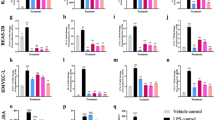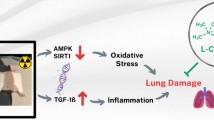Abstract
The present study was designed to investigate the protective effects of hydrogen sulfide (H2S) against cigarette smoking-induced left ventricular dysfunction in rats. Left ventricular structure and function were assessed using two-dimensional echocardiography. Cardiomyocyte apoptosis was determined by Annexin V/PI and terminal deoxynucleotidyl transferase-mediated dUTP nick end labeling staining. Cardiac autophagy was evaluated by detection of autophagy-related protein expression and observation of autophagosomes. Our results indicated that administration of NaHS (a donor of H2S) could protect against smoking-induced left ventricular systolic dysfunction. H2S was found to exert anti-apoptotic effects in the myocardium of smoking rats by inhibiting JNK and P38 mitogen-activated protein kinases pathways and activating PI3K/Akt signaling. Moreover, H2S could also reduce smoking-induced autophagic cell death via regulation of AMPK/mTOR signaling pathway. In conclusion, our study demonstrates that H2S can improve left ventricular systolic function in smoking rats via regulation of apoptosis and autophagy.







Similar content being viewed by others
References
Burns DM (2003) Epidemiology of smoking-induced cardiovascular disease. Prog Cardiovasc Dis 46(1):11–29
Tonstad S, Andrew Johnston J (2006) Cardiovascular risks associated with smoking: a review for clinicians. Eur J Cardiovasc Prev Rehabil 13(4):507–514
Erhardt L (2009) Cigarette smoking: an undertreated risk factor for cardiovascular disease. Atherosclerosis 205(1):23–32
Zhou X, Li C, Xu W, Chen J (2012) Trimetazidine protects against smoking-induced left ventricular remodeling via attenuating oxidative stress, apoptosis, and inflammation. PLoS ONE 7(7):e40424
Zhou X, Li C, Xu W, Chen J (2013) Protective effects of valsartan against cigarette smoke-induced left ventricular systolic dysfunction in rats. Int J Cardiol 167(3):677–680
Elrod JW, Calvert JW, Morrison J, Doeller JE, Kraus DW, Tao L, Jiao X, Scalia R, Kiss L, Szabo C, Kimura H, Chow CW, Lefer DJ (2007) Hydrogen sulfide attenuates myocardial ischemia-reperfusion injury by preservation of mitochondrial function. Proc Natl Acad Sci USA 104(39):15560–15565
Yao LL, Huang XW, Wang YG, Cao YX, Zhang CC, Zhu YC (2010) Hydrogen sulfide protects cardiomyocytes from hypoxia/reoxygenation-induced apoptosis by preventing GSK-3beta-dependent opening of mPTP. Am J Physiol Heart Circ Physiol 298(5):H1310–H1319
Sun YG, Cao YX, Wang WW, Ma SF, Yao T, Zhu YC (2008) Hydrogen sulphide is an inhibitor of L-type calcium channels and mechanical contraction in rat cardiomyocytes. Cardiovasc Res 79(4):632–641
Chunyu Z, Junbao D, Dingfang B, Hui Y, Xiuying T, Chaoshu T (2003) The regulatory effect of hydrogen sulfide on hypoxic pulmonary hypertension in rats. Biochem Biophys Res Commun 302(4):810–816
Su YW, Liang C, Jin HF, Tang XY, Han W, Chai LJ, Zhang CY, Geng B, Tang CS, Du JB (2009) Hydrogen sulfide regulates cardiac function and structure in adriamycin-induced cardiomyopathy. Circ J 73(4):741–749
Mughal W, Dhingra R, Kirshenbaum LA (2012) Striking a balance: autophagy, apoptosis, and necrosis in a normal and failing heart. Curr Hypertens Rep 14(6):540–547
Nishida K, Otsu K (2008) Cell death in heart failure. Circ J 72(Suppl A):A17–A21
Lee Y, Gustafsson AB (2009) Role of apoptosis in cardiovascular disease. Apoptosis 14(4):536–548
Narula J, Haider N, Arbustini E, Chandrashekhar Y (2006) Mechanisms of disease: apoptosis in heart failure—seeing hope in death. Nat Clin Pract Cardiovasc Med 3(12):681–688
Nishida K, Kyoi S, Yamaguchi O, Sadoshima J, Otsu K (2009) The role of autophagy in the heart. Cell Death Differ 16(1):31–38
Edinger AL, Thompson CB (2004) Death by design: apoptosis, necrosis and autophagy. Curr Opin Cell Biol 16(6):663–669
Gupta S, Kass GE, Szegezdi E, Joseph B (2009) The mitochondrial death pathway: a promising therapeutic target in diseases. J Cell Mol Med 13(6):1004–1033
Riedl SJ, Shi Y (2004) Molecular mechanisms of caspase regulation during apoptosis. Nat Rev Mol Cell Biol 5(11):897–907
Youle RJ, Strasser A (2008) The BCL-2 protein family: opposing activities that mediate cell death. Nat Rev Mol Cell Biol 9(1):47–59
Brunelle JK, Letai A (2009) Control of mitochondrial apoptosis by the Bcl-2 family. J Cell Sci 122(Pt 4):437–441
Chang L, Karin M (2001) Mammalian MAP kinase signalling cascades. Nature 410(6824):37–40
Raman M, Chen W, Cobb MH (2007) Differential regulation and properties of MAPKs. Oncogene 26(22):3100–3112
Franke TF (2008) PI3K/Akt: getting it right matters. Oncogene 27(50):6473–6488
Vasudevan KM, Garraway LA (2010) AKT signaling in physiology and disease. Curr Top Microbiol Immunol 347:105–133
Kim J, Kundu M, Viollet B, Guan KL (2011) AMPK and mTOR regulate autophagy through direct phosphorylation of Ulk1. Nat Cell Biol 13(2):132–141
Jung CH, Ro SH, Cao J, Otto NM, Kim DH (2010) mTOR regulation of autophagy. FEBS Lett 584(7):1287–1295
Conflict of interest
The authors declare no conflict of interest.
Author information
Authors and Affiliations
Corresponding author
Rights and permissions
About this article
Cite this article
Zhou, X., An, G. & Chen, J. Hydrogen sulfide improves left ventricular function in smoking rats via regulation of apoptosis and autophagy. Apoptosis 19, 998–1005 (2014). https://doi.org/10.1007/s10495-014-0978-z
Published:
Issue Date:
DOI: https://doi.org/10.1007/s10495-014-0978-z




